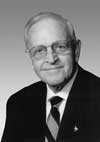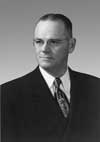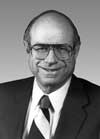Ray A. Barnhart

Ray Barnhart (Marietta College ’50; University of Houston ’51) combined political skills with a career long transportation interest to significantly impact our transportation system. An Eagle Scout, he was a Texas State Representative (1972-73) and a Commissioner of the Texas Department of Highways and Public Transportation (1979-81).
In 1981, President Reagan nominated Ray Barnhart as Federal Highway Administrator. He served in this capacity from 1981-87. Ray insisted that transportation policy be based upon engineering and economic principles. Under his stewardship, Congress agreed to increase motor fuel taxes. He established the Federal/State Technology Transfer Center Program, fought to preserve the sanctity of the highway trust fund, insisted on returning decision power to the states, and initiated the nationwide effort to stop the theft of fuel taxes.
Upon his retirement from FHWA, the U.S. House of Representatives noted in a resolution that “the United States Government expresses its gratitude to Ray A. Barnhart for his honest, effective and meaningful efforts to preserve and improve the Federal-Aid System—one of the Nation’s most vital assets…”
As a private citizen, Ray continues to identify and advocate solutions to transportation issues.
Walter J. Humann

Walter J. “Walt” Humann (MIT ’59) has had two simultaneously successful careers in Dallas. One is in business, and the other is in public service. He heads his own firm, WJH Corporation, and has held top management positions in several corporations as well as serving on both corporate and non-profit boards.
In his public service career, Mr. Humann has the quiet tenacity and perceptive vision to develop private/public partnerships to address pressing urban problems. He has spearheaded significant community improvements in the areas of transportation—reconstruction of North Central Expressway, and creation and implementation of DART (Dallas Area Rapid Transit)—education, community and race relations, government reorganization, and urban planning, design and beautification. He has applied his considerable skills and finesse to develop consensus on complex transportation issues among groups with diverse opinions.
Walt Humann has received numerous civic awards, including the prestigious Linz Award in 1997 for his leadership in bringing North Central Expressway and DART to fruition.
For over 30 years, Mr. Humann has had an ongoing, positive influence on the quality of life in Dallas and North Texas by facilitating improvements in the transportation infrastructure.
Harold J. McKenzie

A native Texan, Harold McKenzie’s (A&M ’27) career in the railroad industry spanned the period from 1926 to 1969. While working for the Texas and New Orleans Railroad, he served as project engineer for the replacement of the spectacular Pecos River bridge.
A hands-on leader, a man of vision and innovation, in 1951 he was named President of the Cotton Belt Railroad. Harold McKenzie reorganized the company and moved the headquarters from St. Louis to Tyler. He turned this railroad into one of the country’s best run properties. In 15 years, the Cotton Belt doubled tonnage carried and net income, while reducing the number of employees by half. At the same time, the railroad emphasized safety and received five significant safety awards.
His contributions to improving the railroad’s service area were also substantial. An example was his role in securing right-of-way for the Dallas North Tollway, and its main plaza was subsequently named the “McKenzie Plaza.”
Upon retirement in 1969, he devoted his talents to civic affairs in Tyler, and was a leader in establishing the University of Texas at Tyler.
Raymond E. Stotzer, Jr.

Raymond Stotzer (A&M ’46) began his career with the Texas Highway Department in 1947. He served as District Engineer in both Pharr (1968-74) and San Antonio (1974-86) and was Engineer-Director from 1986 until his death in 1989. He was a charismatic leader who excelled in promoting relationships of mutual trust and respect.
Raymond led the development and construction of the Queen Isabella Causeway, Texas’ longest bridge, and he addressed congestion in San Antonio by improving major freeways. Raymond was willing to take risks to pursue innovative ideas in areas such as organizational structure, highway design, and right-of-way acquisition.
As Engineer-Director, he achieved a reputation for deftly balancing the interests of rural and urban districts. Priority was given to enhancing urban mobility and, as retirements increased, Raymond created programs to train and educate young engineers and technicians.
Raymond Stotzer was a recipient of numerous awards, including being named a Distinguished Alumnus of the College of Engineering at Texas A&M. Governor Clements observed that “Texans today and for years to come will reap the benefits of his engineering talents.”